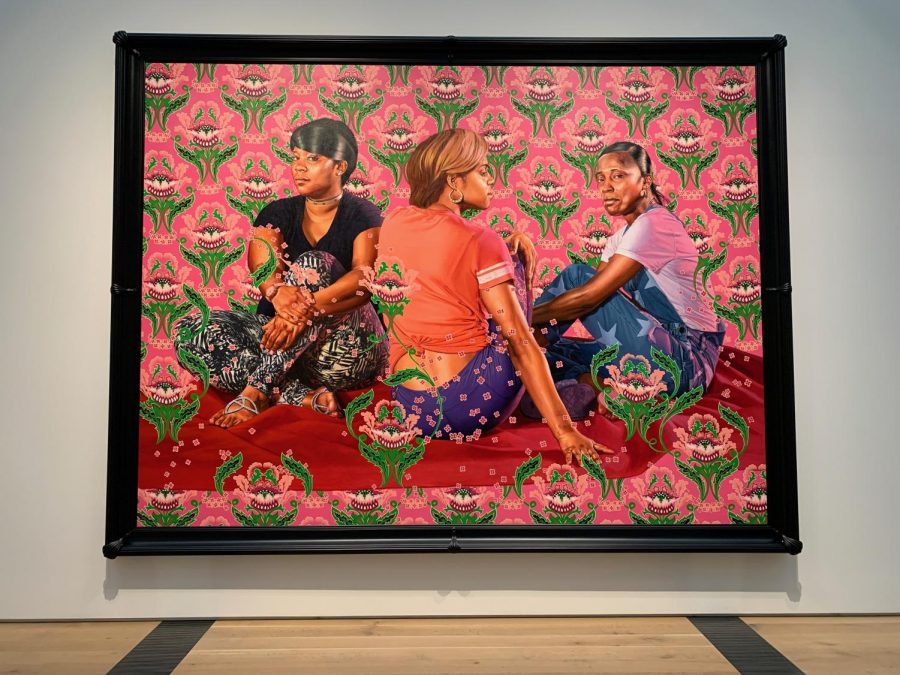Kehinde Wiley Saint Louis Art Museum Exhibit
Kehinde Wiley, who painted President Obama’s official portrait for the Smithsonian National Portrait Gallery, currently has a featured collection at the Saint Louis Art Museum until Feb. 10. In these 11 stunning portraits, Wiley reinterprets classical works of Western art to replace white, often aristocratic subjects with African Americans from St. Louis and Ferguson. Eight of the original pieces Wiley uses as inspiration can be found in the Saint Louis Art Museum.
Although Wiley’s subjects strike nearly the same poses as the landed gentry of the works in the museum, he adds several twists that give this collection a full life of its own. What is most extraordinary about them is that they are all from north St. Louis and Ferguson and were approached on the street by Wiley himself. It is incredibly uncommon and refreshing to see everyday people portrayed with the same dignity as that of the president.
A lover of art history, the 41-year-old Wiley’s reinterpretation is purposeful. He grew up in South Central Los Angeles, and his interest in art began at a young age when his mother enrolled him in after-school art classes. His work seeks in part to address the absence of positive depictions of black people in Western art, particularly portraiture, which has historically been reserved for only the most wealthy and privileged individuals. Wiley stated in one interview, “I wanted to be able to treat them with the same loving hand, with the same attention to detail that was devoted to some of the most powerful people in European history.”
Some of the original subjects that Wiley reimagines have direct connections with slavery and the oppression of black people. For example, Robert Hay Drummond, an Archbishop of York during the 18th century, aided in the operation of an infamous Caribbean sugar plantation. Similarly, Major Moses Seymour, a general in the American Continental Army during the Revolutionary War, owned slaves in Connecticut.
Another deviation of Wiley’s paintings from the original works is his backgrounds, which are lush with a dizzying variety of color and patterns. While the originals have more traditional backgrounds of nature or domestic scenes with muted and cool-toned colors, Wiley’s burst with elaborate floral patterns, some of which are inspired by European, African and Islamic textile designs. Vines laden with fruits and flowers overlap the incredibly realistic, at times photo-like subjects in Wiley’s works.
These decorative backgrounds serve a much more important function than simply pleasing the eye. Just as the poses his subjects make are chosen to portray black people as powerful characters, a role they have often been denied in Western art, Wiley’s backgrounds challenge the often problematic and negative portrayal of black Americans and black bodies in our culture. Wiley compared subjects’ struggle for the viewer’s attention to that of black Americans to be portrayed in a more empowering way. “Their competition for the picture plane exists in direct relationship with my insistence upon the black body being in the forefront within a museum space, that sense that I deserve to be here, that constant fight for presence,” said Wiley.
Other smaller changes in Wiley’s portraits are also significant. Occasionally the gender of his subject is changed, as in “Portrait of a Florentine Nobleman,” “Charles I” or “Mercury.” Most of the subjects in the originals are men, but in his collection, there are twice as many women as men. Wiley began painting almost exclusively men, but his work in the last several years has featured many more women, and the collection at the museum are representative of this trend.
Another distinct feature in Wiley’s portraits is that his subjects wear their own modern clothing, including shirts with “Just Do It” logos and Nike shoes. Commenting on the importance of branding, Wiley stated in one interview, “Branding says a lot about luxury, and about exclusion, and about the choices that manufactures make… And the African American community has always been expert at taking things and repurposing them toward their own ends.”
Wiley’s works offer much for viewers to digest and reconsider about the representation of African Americans. And perhaps seeing one’s neighbors depicted in such majesty will inspire exhibit-goers to think just a little differently about those they pass on the street and not only acknowledge, but celebrate the beauty in ordinary people and things.
Your donation will support the student journalists of Saint Louis University.





Wes Faulconer • Feb 14, 2019 at 9:42 am
I really enjoyed reading this article about the Kehinde Wiley Art exhibit. It conveys clearly what the artist is doing and
the reasons why the artist is taking this direction. Which makes you think a little differently about the ordinary things and especially people.